
Sapphire Atlantis Radeon 9800 XT
Written by John Yan on 11/17/2003 for
PC
More On:
Sapphire Atlantis Radeon 9800 XT
ATi’s latest offering in the Atlantis Radeon 9800 XT offers arguably the fastest graphics available for the PC. If it’s power you want, the Atlantis Radeon 9800 XT is the card to get. Sapphire was nice enough to send us their version of the card entitled Atlantis Radeon 9800XT. Let’s see how it does and how much faster it is over the regular Radeon 9800 Pro.

The Atlantis 9800 Pro XT comes in two flavors: 128MB and 256MB variations. What we have today is the 256MB card. The high end Atlantis Radeon 9800 XT’s R360 core is clocked at 412 MHz and the memory is clocked at 730 MHz. For comparison, the Radeon 9800 Pro’s clock and memory speed are 380 MHz and 700 MHz respectively. It’s still based on a .15 micron process, not the .13 micron used in the Radeon 9600 Pro and there aren’t any new changes over the Radeon 9800 Pro other than higher clock speeds. Below is a comparison table between the two 9800 variants.

Physically, the card is pretty heavy. And from the pictures, the heatsink and fan really sticks out. It’s a large departure from the cooling solution used in the Radeon 9800 Pro. The copper heatsink is actually on both sides of the card. A large fan keeps airflow through to cool the heatsink. The spiral fan is encased in a plastic casing while copper heatsink is covered by a nice picture of the Sapphire logo and grey alien that’s featured on the box cover. Even with the larger cooling solution, the card is still a one slot solution. And the card can throttle the fan speed faster or slower depending on the temperature it detects. It would be a nice picture for the side of a clear Shuttle case to showcase. I was really surprised at how quiet the card was. It won’t drown out the sounds around you and that’s good for people who want a quieter PC.

The bracket has a DVI output, VGA output, and an S-Video out. As per most non-All-in-Wonder Radeon cards, the Atlantis Radeon 9800 XT supports dual monitors. That’s a plus for people like me who program for a living. Developing on two monitors is so much better than one and if you’re also a heavy gamer, the Atlantis Radeon 9800 XT gives you the gaming performance as well as the developer flexibility.
The software bundle offers a little more than ATi. It still has a free Steam download code for Half-Life 2 and that alone is a big upgrade over Morrowind. Sapphire was kind enough to also include a free copy of Tomb Raider : Angel of Darkness and a copy of PowerDVD for your viewing pleasure. I’m happy that Sapphire just didn’t stick the card and Half-Life 2 in their box but took the effort to include two other pieces of software. And their Redline overclocking/tweaking software is also in the box as per all Sapphire products.
Cables included a composite cable and an S-Video cable. There’s also a DVI->VGA adapter and an S-Video -> composite adapter. The last include in the package is a power cable splitter. The Atlantis Radeon 9800 XT card needs an external power supply and Sapphire has include a Molex splitter in case you are low on power connectors.
Now that we got the basic stuff out of the way, let’s get into the meat of the review. The card was used in the following test system:
AMD Athlon XP 2400+
512MB PC3200 Crucial ram
ABIT NF7-S motherboard
Maxtor 120GIG 7200 RPM hard drive
Windows XP Service Pack 1
I will be comparing the card to an All-in-Wonder 9800 Pro provided by ATi. The All-in-Wonder 9800 Pro is clocked and performs exactly the same as a regular Radeon 9800 Pro. We’ll be going through various game genres and seeing how they perform against each other as well as seeing how much of a performance hit you get by turning on anti-aliasing and anisotropic filtering on the Atlantis Radeon 9800 XT. First up are two synthetic benchmarks.
Futuremark’s 3D Mark 2001 SE has been around a while now. With the changes and controversy over 3D Mark 03, I decided to go with the previous version for the review. Here are the scores:
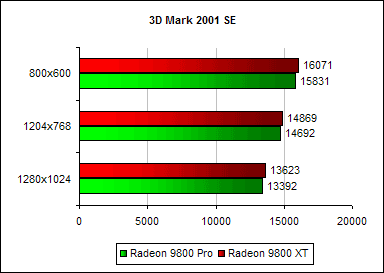
Scores compared to the Radeon 9800 Pro are close throughout all resolutions. Let’s move on to the next synthetic benchmark.
Aquamark 3 is actually based off a real world game engine. While still synthetic, it does offer a score based on an engine that is used in production for a game.
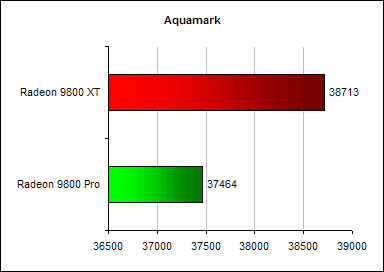
The Atlantis Radeon 9800 XT scores roughly 1300 more aquamarks over a Radeon 9800 Pro. Now let’s start getting into real games to see how this card performs.
The first person shooter, Unreal Tournament 2003, is up next and using [H]ardOCP’s utility, I ran the cards through the flybys. For the review, I took the scores presented when going through DM-Phobos2. Let’s see how they hold up.
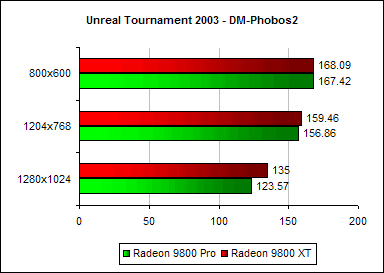
As resolutions are increased, the lead that the Atlantis Radeon 9800 XT becomes greater. While not that much at 800x600, you can see a nice double digit increase of about 13 frames per second at 1280x1024.
Splinter Cell’s a nice third person game that has a lot of nice effects. Beyond3D’s benchmark was used here to determine the scores.
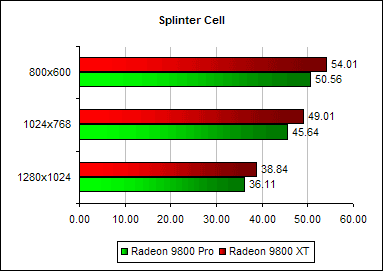
The differences in scores aren’t as much here but the Atlantis Radeon 9800 XT is still ahead of its younger brother.
For Dungeon Siege, I was only successful in running the tests at 1024x768. This happened with all cards I used so there must be something in my benchmarking program that’s preventing me from selecting the correct resolution. In any case, here are the scores.
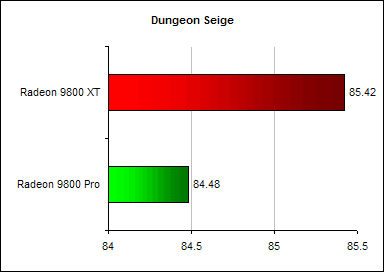
Again, there’s a small increase over what the Radeon 9800 Pro does.
Finally, Comanche 4 was used. The game is more CPU dependent than video card dependent so don’t be surprised if the scores are very close together for both cards. The tests were done with sound disabled in the program.
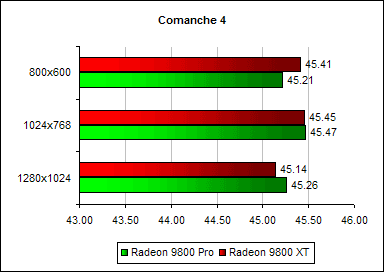
Not surprising here, the cards are nearly identical in this benchmark.
For performance with anti-aliasing and anisotropic filter on, we turn to 3D Mark 2001 SE and Unreal Tournament 2003. For 3D Mark 2001 SE, I had the program turn on 4X anti-aliasing. Here’s the comparison of the scores with the option off and on.
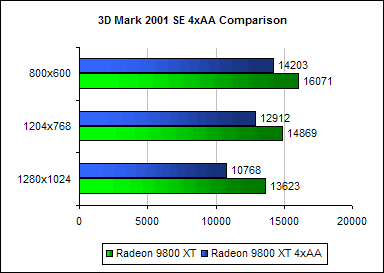
With Unreal Tournament 2003, I went into the control panel and moved the sliders to 6X anti-aliasing and 16X anisotropic filtering. Running through the flybys again, I took the score for DM-Phobos2. Here are the comparison graphs.
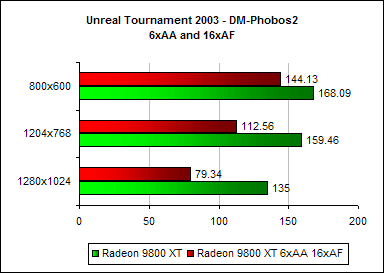
With 3D Mark 2001 SE, the card only drops 12% at 800x600 and 21% at 1280x1024. That’s just with 4xAA though. Turning the anti-aliasing up to 6X and using 16X anisotropic filtering, the card’s power drops 15% at 800x600 and drops a whopping 42% at 1280x1024. At lower resolutions, the drop isn’t that considerable and I do like the picture quality with both anti-aliasing and anisotropic filtering enabled. Turning both up on high resolutions will tax the card tremendously however.
Overall, the power of the card is more than the already powerful Radeon 9800 Pro. And it does show when you turn on all the options such as anti-aliasing and anisotropic filtering.
As with my All-in-Wonder 9600 Pro review, I had problems playing Call of Duty with Catalyst 3.8. Crashes would occur at random points. Reverting to 3.7 drivers fixed the problem and the card ran stable and problem free. With my two weeks of using the card, I had no problems with any games I played.
Image quality, to the naked eye, seems good and taking some looks at various screenshots I took also showed nothing out of the ordinary. The one thing about ATi cards is that they produce very good image quality and there’s nothing that I saw to say otherwise with the Atlantis Radeon 9800 XT.
If you want power and have the money to spend, then the Sapphire Atlantis Radeon 9800 XT is the card to get. It was stable and you'll be set in terms of quality and performance for current and games in the near future with DirectX 9++ support. Sapphire was nice enough to also include Tomb Raider: Angel of Darkness for you to play with while you are waiting for that OTHER game from Valve Software to be released. Sapphire's line of ATi based cards has always been solid and this is no exception. For those that want the best and can afford it, I highly recommend the Atlantis Radeon 9800 XT.

The Atlantis 9800 Pro XT comes in two flavors: 128MB and 256MB variations. What we have today is the 256MB card. The high end Atlantis Radeon 9800 XT’s R360 core is clocked at 412 MHz and the memory is clocked at 730 MHz. For comparison, the Radeon 9800 Pro’s clock and memory speed are 380 MHz and 700 MHz respectively. It’s still based on a .15 micron process, not the .13 micron used in the Radeon 9600 Pro and there aren’t any new changes over the Radeon 9800 Pro other than higher clock speeds. Below is a comparison table between the two 9800 variants.

Physically, the card is pretty heavy. And from the pictures, the heatsink and fan really sticks out. It’s a large departure from the cooling solution used in the Radeon 9800 Pro. The copper heatsink is actually on both sides of the card. A large fan keeps airflow through to cool the heatsink. The spiral fan is encased in a plastic casing while copper heatsink is covered by a nice picture of the Sapphire logo and grey alien that’s featured on the box cover. Even with the larger cooling solution, the card is still a one slot solution. And the card can throttle the fan speed faster or slower depending on the temperature it detects. It would be a nice picture for the side of a clear Shuttle case to showcase. I was really surprised at how quiet the card was. It won’t drown out the sounds around you and that’s good for people who want a quieter PC.

The bracket has a DVI output, VGA output, and an S-Video out. As per most non-All-in-Wonder Radeon cards, the Atlantis Radeon 9800 XT supports dual monitors. That’s a plus for people like me who program for a living. Developing on two monitors is so much better than one and if you’re also a heavy gamer, the Atlantis Radeon 9800 XT gives you the gaming performance as well as the developer flexibility.
The software bundle offers a little more than ATi. It still has a free Steam download code for Half-Life 2 and that alone is a big upgrade over Morrowind. Sapphire was kind enough to also include a free copy of Tomb Raider : Angel of Darkness and a copy of PowerDVD for your viewing pleasure. I’m happy that Sapphire just didn’t stick the card and Half-Life 2 in their box but took the effort to include two other pieces of software. And their Redline overclocking/tweaking software is also in the box as per all Sapphire products.
Cables included a composite cable and an S-Video cable. There’s also a DVI->VGA adapter and an S-Video -> composite adapter. The last include in the package is a power cable splitter. The Atlantis Radeon 9800 XT card needs an external power supply and Sapphire has include a Molex splitter in case you are low on power connectors.
Now that we got the basic stuff out of the way, let’s get into the meat of the review. The card was used in the following test system:
AMD Athlon XP 2400+
512MB PC3200 Crucial ram
ABIT NF7-S motherboard
Maxtor 120GIG 7200 RPM hard drive
Windows XP Service Pack 1
I will be comparing the card to an All-in-Wonder 9800 Pro provided by ATi. The All-in-Wonder 9800 Pro is clocked and performs exactly the same as a regular Radeon 9800 Pro. We’ll be going through various game genres and seeing how they perform against each other as well as seeing how much of a performance hit you get by turning on anti-aliasing and anisotropic filtering on the Atlantis Radeon 9800 XT. First up are two synthetic benchmarks.
Futuremark’s 3D Mark 2001 SE has been around a while now. With the changes and controversy over 3D Mark 03, I decided to go with the previous version for the review. Here are the scores:

Scores compared to the Radeon 9800 Pro are close throughout all resolutions. Let’s move on to the next synthetic benchmark.
Aquamark 3 is actually based off a real world game engine. While still synthetic, it does offer a score based on an engine that is used in production for a game.

The Atlantis Radeon 9800 XT scores roughly 1300 more aquamarks over a Radeon 9800 Pro. Now let’s start getting into real games to see how this card performs.
The first person shooter, Unreal Tournament 2003, is up next and using [H]ardOCP’s utility, I ran the cards through the flybys. For the review, I took the scores presented when going through DM-Phobos2. Let’s see how they hold up.

As resolutions are increased, the lead that the Atlantis Radeon 9800 XT becomes greater. While not that much at 800x600, you can see a nice double digit increase of about 13 frames per second at 1280x1024.
Splinter Cell’s a nice third person game that has a lot of nice effects. Beyond3D’s benchmark was used here to determine the scores.

The differences in scores aren’t as much here but the Atlantis Radeon 9800 XT is still ahead of its younger brother.
For Dungeon Siege, I was only successful in running the tests at 1024x768. This happened with all cards I used so there must be something in my benchmarking program that’s preventing me from selecting the correct resolution. In any case, here are the scores.

Again, there’s a small increase over what the Radeon 9800 Pro does.
Finally, Comanche 4 was used. The game is more CPU dependent than video card dependent so don’t be surprised if the scores are very close together for both cards. The tests were done with sound disabled in the program.

Not surprising here, the cards are nearly identical in this benchmark.
For performance with anti-aliasing and anisotropic filter on, we turn to 3D Mark 2001 SE and Unreal Tournament 2003. For 3D Mark 2001 SE, I had the program turn on 4X anti-aliasing. Here’s the comparison of the scores with the option off and on.

With Unreal Tournament 2003, I went into the control panel and moved the sliders to 6X anti-aliasing and 16X anisotropic filtering. Running through the flybys again, I took the score for DM-Phobos2. Here are the comparison graphs.

With 3D Mark 2001 SE, the card only drops 12% at 800x600 and 21% at 1280x1024. That’s just with 4xAA though. Turning the anti-aliasing up to 6X and using 16X anisotropic filtering, the card’s power drops 15% at 800x600 and drops a whopping 42% at 1280x1024. At lower resolutions, the drop isn’t that considerable and I do like the picture quality with both anti-aliasing and anisotropic filtering enabled. Turning both up on high resolutions will tax the card tremendously however.
Overall, the power of the card is more than the already powerful Radeon 9800 Pro. And it does show when you turn on all the options such as anti-aliasing and anisotropic filtering.
As with my All-in-Wonder 9600 Pro review, I had problems playing Call of Duty with Catalyst 3.8. Crashes would occur at random points. Reverting to 3.7 drivers fixed the problem and the card ran stable and problem free. With my two weeks of using the card, I had no problems with any games I played.
Image quality, to the naked eye, seems good and taking some looks at various screenshots I took also showed nothing out of the ordinary. The one thing about ATi cards is that they produce very good image quality and there’s nothing that I saw to say otherwise with the Atlantis Radeon 9800 XT.
If you want power and have the money to spend, then the Sapphire Atlantis Radeon 9800 XT is the card to get. It was stable and you'll be set in terms of quality and performance for current and games in the near future with DirectX 9++ support. Sapphire was nice enough to also include Tomb Raider: Angel of Darkness for you to play with while you are waiting for that OTHER game from Valve Software to be released. Sapphire's line of ATi based cards has always been solid and this is no exception. For those that want the best and can afford it, I highly recommend the Atlantis Radeon 9800 XT.
A expensive but powerful card. The Atlantis Radeon 9800 XT's got a lot of bang for a lot of bucks.
Rating: 9.2 Class Leading
* The product in this article was sent to us by the developer/company.

About Author
I've been reviewing products since 1997 and started out at Gaming Nexus. As one of the original writers, I was tapped to do action games and hardware. Nowadays, I work with a great group of folks on here to bring to you news and reviews on all things PC and consoles.
As for what I enjoy, I love action and survival games. I'm more of a PC gamer now than I used to be, but still enjoy the occasional console fair. Lately, I've been really playing a ton of retro games after building an arcade cabinet for myself and the kids. There's some old games I love to revisit and the cabinet really does a great job at bringing back that nostalgic feeling of going to the arcade.
View Profile